Non-domestic rates/Council Tax second and empty homes consultation: business and regulatory impact assessment
Business and regulatory impact assessment (BRIA) relating to the consultation on council tax for second and empty homes, and thresholds for non-domestic rates.
Partial Business and Regulatory Impact Assessment (BRIA) : Non-Domestic Rates / Council Tax Second and Empty Homes: Consultation
Purpose and intended effect
This is a Partial Business and Regulatory Impact Assessment (BRIA) in connection with the consultation published on 18 April 2023.
The consultation seeks views on how local taxation can help councils make best use of existing housing stock. This is not about a one size fits all solution. Nationally the aim is to encourage more residential accommodation to be used as homes for living in and for these to be occupied for more of the time. Local areas are best placed, however, to decide how to achieve the right balance in the use of housing to meet local needs and to support thriving communities and economies.
The proposal is whether to provide additional powers to councils allowing them discretion to:
- charge up to a 100% premium (double the full rate) on council tax for second homes (councils already have powers to charge a 100% premium on homes which have been empty for 12 months or longer)
- charge more than a 100% premium on council tax for second homes and homes which have been empty for 12 months or longer
As some second homes are used as short-term lets, we are also asking for views on whether the current non-domestic rates thresholds for self-catering accommodation should change, and/or if councils should have discretion to set them.
We welcome comments and suggestions for developing the Business and Regulatory Impact Assessment. This will help ensure that discussions about the impacts of proposed changes are as well informed as possible.
Background
In March 2021 we published Scotland's first national population strategy. Its vision for a future Scotland focused on taking a place-based whole-system approach to drive local needs around the economy, infrastructure, public services and housing.
At the same time the Scottish Government published its Housing to 2040 Strategy. Its bold vision and principles included prioritising homes for living in, and not accumulating wealth.
In addition to the national population strategy and Housing to 2040, our Shared Policy Programme with the Scottish Green Party, commits us to providing councils with tools and powers to support them to make best use of existing housing stock. This includes enabling councils to manage the number of long-term empty homes, short-term lets and second homes.
The Scottish Government has already delivered measures which ensure:
- councils can change or remove the discount for council tax charged on second homes
- councils can change the discount for council tax on empty properties, and they can also remove the discount or charge up to a 100% premium (double the full rate) on council tax for homes empty longer than 12 months
- councils can use planning as a tool to manage numbers of short-term lets by designating all or part of their area as a Short-term Let Control Area
- the total purchase price of an additional property (if over £40,000) is liable for an additional dwelling supplement on Land and Buildings Transaction Tax at a rate of 6%
- a requirement for self-catering holiday accommodation to be actually let for a period of at least 70 days and available to let for 140 days or more in each financial year, to be liable for non-domestic rates rather than council tax
Our aim is for everyone in Scotland to live in safe, secure and warm homes. We need to do more to prioritise housing for permanent accommodation, whether this is in the rented sector or home ownership.
Councils could use these proposed additional powers to encourage behavioural change to disincentivise multiple home ownership and low occupancy rates, as well as to help raise additional revenue for re-investment in affordable housing and other local services.
The discretionary nature of these additional powers would mean that councils could decide whether and how to utilise them based on local circumstances, including balancing the needs and concerns of their communities with wider economic and tourism interests.
Definition
Second homes and empty homes (unoccupied dwellings) are currently defined in the Council Tax (Variation for Unoccupied Dwellings) (Scotland) Regulations 2013 as follows:
- a "second home" is a dwelling which is no one's sole or main residence but which is furnished and lived in for at least 25 days during the chargeable 12 month period
- an "unoccupied dwelling" is a dwelling, which is no one's sole or main residence but which is not used as a second home
In this consultation paper, short-term lets is a wide term used to refer to the whole or part of accommodation provided to one or more guests on a commercial basis that does not become the main residence of the guest/s. There are different types of short-term lets such as self-catering accommodation, B&Bs, guest houses, home letting and home sharing. What local taxation short-term lets are liable for will vary depending on the type of short-term let and applicable taxation rules.
For example, if a second home is used as self-catering accommodation it will be liable for non-domestic rates if the premises is:
- not the sole or main residence of any person; and
- being made available for letting, on a commercial basis and with a view to the making of profit, for 140 days or more in the financial year, and have in practice been let in the financial year for a total of 70 days
If the self-catering accommodation does not meet the above criteria and thresholds it is liable for council tax instead.
B&Bs and guest houses may be liable for non-domestic rates if their operation has capacity to cater for more than 6 people at any one time, regardless of how many days the premises or rooms are available or actually let.
Context
As at September 2022 there were 24,287[1] second homes and 42,865[2] long-term empty (6 months or more) homes (classified for council tax purposes). This equates to around 1% of all residential accommodation in Scotland being second homes and 2% being long-term empty (6 months or more) homes.[3]
The evolution of the number of second homes, long-term empty (6 months or more) properties and unoccupied exemptions[4] can be seen in Figure 1.
It is important to note that legislative changes made in 2013 allowed councils to reduce the discount on both second homes and empty homes, but in the case of homes which had been empty for longer than 12 months also gave councils the power to charge up to a 100% premium.
During the period 2012 to 2014, the number of second homes decreased by 12,700 and the number of empty homes increased by 6,400. This is likely to be linked at least in part to a reclassification of properties as councils improved their data collection and enforcement because they had used this discretion to charge different levels of council tax on empty and second homes.
Another factor in the decrease of second home numbers in the past decade may be the rise in the number of short-term lets. Prior to 1 April 2022, eligibility for non-domestics rates was based on self-catering accommodation being available to let for 140 days. The Barclay Review conducted in 2017 noted there was no requirement to provide evidence of this availability to let. Since 1 April 2022, the threshold for self-catering accommodation to be liable for non-domestic rates has been that it is actually let for 70 days or more and available to let for 140 days or more each financial year.
As at 1 July 2022, 88% (16,130) of self-catering accommodation units on the valuation roll were in receipt of Small Business Bonus Scheme at a cost of over £21 million. The majority of these (96%) benefited from 100% relief and therefore paid no local tax.
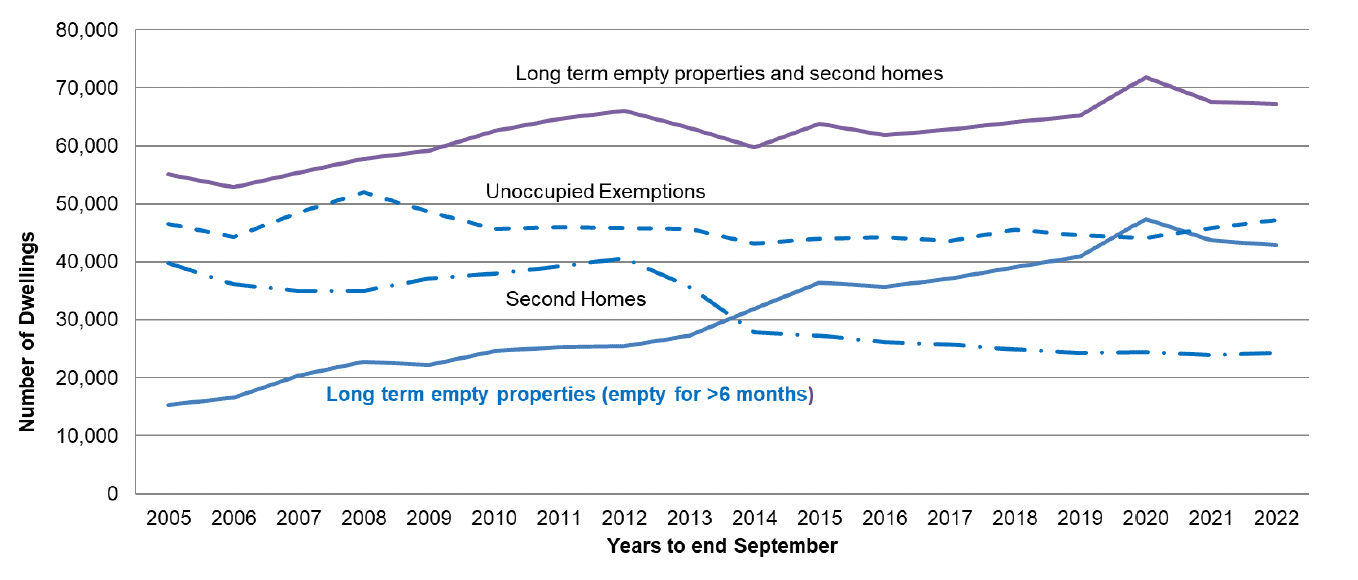
Source: Scottish Government, Housing statistics: Empty properties and second homes
The number of second homes varies considerably between, and within, individual councils, with the peak numbers found mainly in tourist hotspots, rural and island areas. Table 1 shows the proportions of second homes for councils where the proportion is above the national average level of 1%.
| Council Area | Share of second homes |
|---|---|
| Argyll & Bute | 6.2% |
| Na h-Eileanan Siar | 5.9% |
| Orkney Islands | 4.8% |
| Highland | 3.0% |
| North Ayrshire | 2.2% |
| Dumfries & Galloway | 1.8% |
| Moray | 1.7% |
| Scottish Borders | 1.7% |
| Perth & Kinross | 1.6% |
| Shetland Islands | 1.5% |
| Fife | 1.3% |
| Scottish Average | 0.9% |
Source: Scottish Government (Housing statistics: Empty properties and second homes - gov.scot (www.gov.scot)) and CTAXBASE 2022.
Table 1 illustrates that the councils with a high percentage of chargeable second homes tend to be more rural councils. The Scottish Government's Urban Rural Classification provides a consistent way of defining urban and rural areas across Scotland. The classification is based upon two main criteria: (i) population, as defined by the National Records of Scotland (NRS), and (ii) accessibility, based on drive time analysis to differentiate between accessible and remote areas in Scotland. A table outlining the criteria for each category of the 6-fold urban-rural classification is included in Annex A, Table 8.
Figure 2 shows that in September 2021, 10,000 out of the total of 24,000 second homes in Scotland (43%) were situated in remote rural areas[6]. Correspondingly, the share of second homes in total residential stock was much higher in remote rural areas (6.4%) than in Scotland as whole.
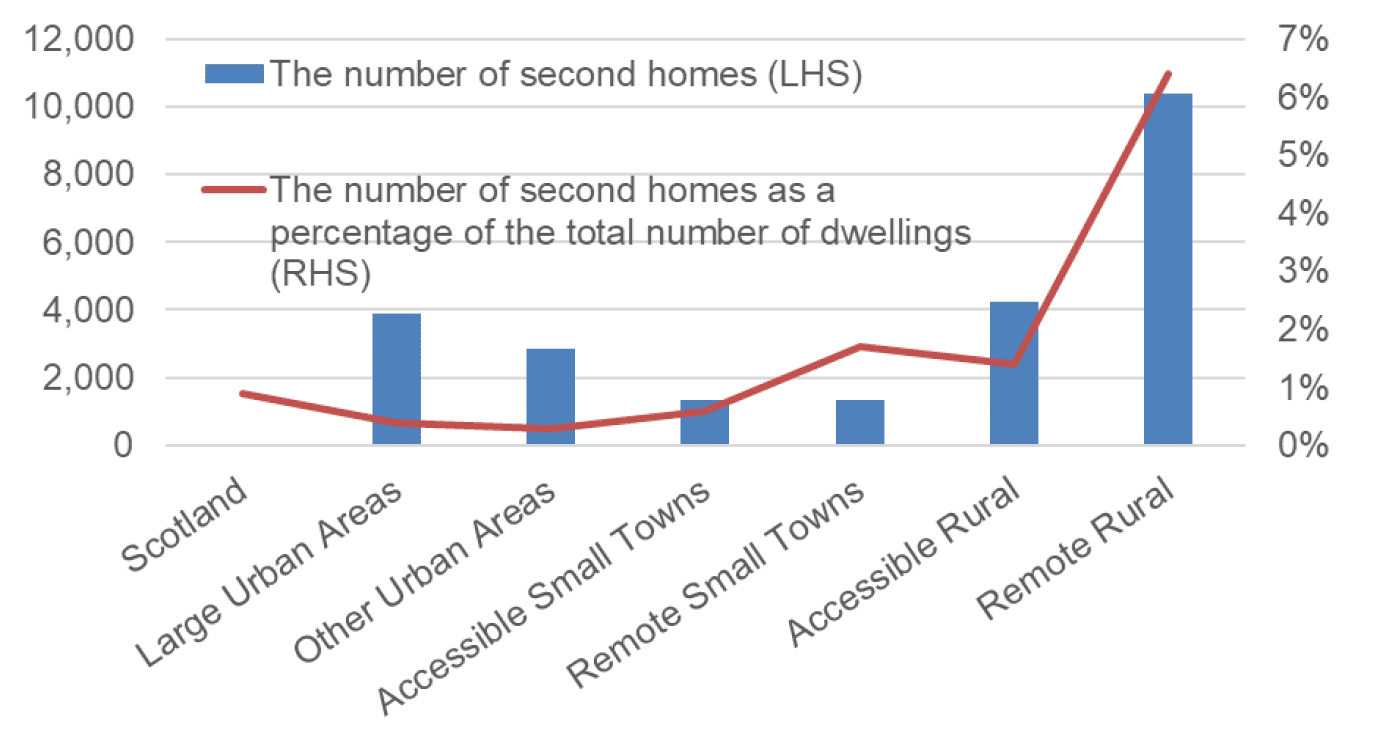
Source: National Records of Scotland (Household and Dwelling Estimates by Urban Rural Classification (2011 Data Zone based) | National Records of Scotland (nrscotland.gov.uk))
Table 2 shows data zone areas where the concentration of second homes as a percentage of the total number of homes is 20% or higher. All of these datazones are classified as either remote rural or accessible rural.
| Datazone | Local Authority Area | Urban-Rural classification | % second homes | No of second homes |
|---|---|---|---|---|
| Earlsferry | Fife | Accessible Rural | 51 | 290 |
| Largs Central and Cumbrae - 06 | North Ayrshire | Remote Rural | 40 | 318 |
| Cowal South - 02 | Argyll and Bute | Remote Rural | 36 | 150 |
| Elie | Fife | Accessible Rural | 31 | 120 |
| Cowal South - 01 | Argyll and Bute | Remote Rural | 28 | 172 |
| Arran - 04 | North Ayrshire | Remote Rural | 27 | 88 |
| Largs Central and Cumbrae - 07 | North Ayrshire | Remote Rural | 26 | 141 |
| Arran - 06 | North Ayrshire | Remote Rural | 26 | 114 |
| Mull, Iona, Coll and Tiree - 01 | Argyll and Bute | Remote Rural | 25 | 170 |
| Cowal North - 01 | Argyll and Bute | Remote Rural | 24 | 164 |
| Arran - 01 | North Ayrshire | Remote Rural | 23 | 142 |
| Rannoch and Aberfeldy - 05 | Perth and Kinross | Remote Rural | 23 | 91 |
| Cullen, Portknockie, Findochty, Drybridge and Berryhillock - 03 | Moray | Remote Rural | 22 | 70 |
| Ross and Cromarty South West - 03 | Highland | Remote Rural | 21 | 119 |
| Arran - 03 | North Ayrshire | Remote Rural | 21 | 83 |
| Whisky Isles - 01 | Argyll and Bute | Remote Rural | 21 | 61 |
| Sutherland North and West - 05 | Highland | Remote Rural | 20 | 92 |
| Badenoch and Strathspey South - 05 | Highland | Remote Rural | 20 | 86 |
| Loch Awe - 02 | Argyll and Bute | Remote Rural | 20 | 83 |
Source: National Records of Scotland (Small Area Statistics on Households and Dwellings | National Records of Scotland (nrscotland.gov.uk)). Data zones are 2011 datazone.
The variation in the concentration of second homes across Scotland can also be viewed graphically.
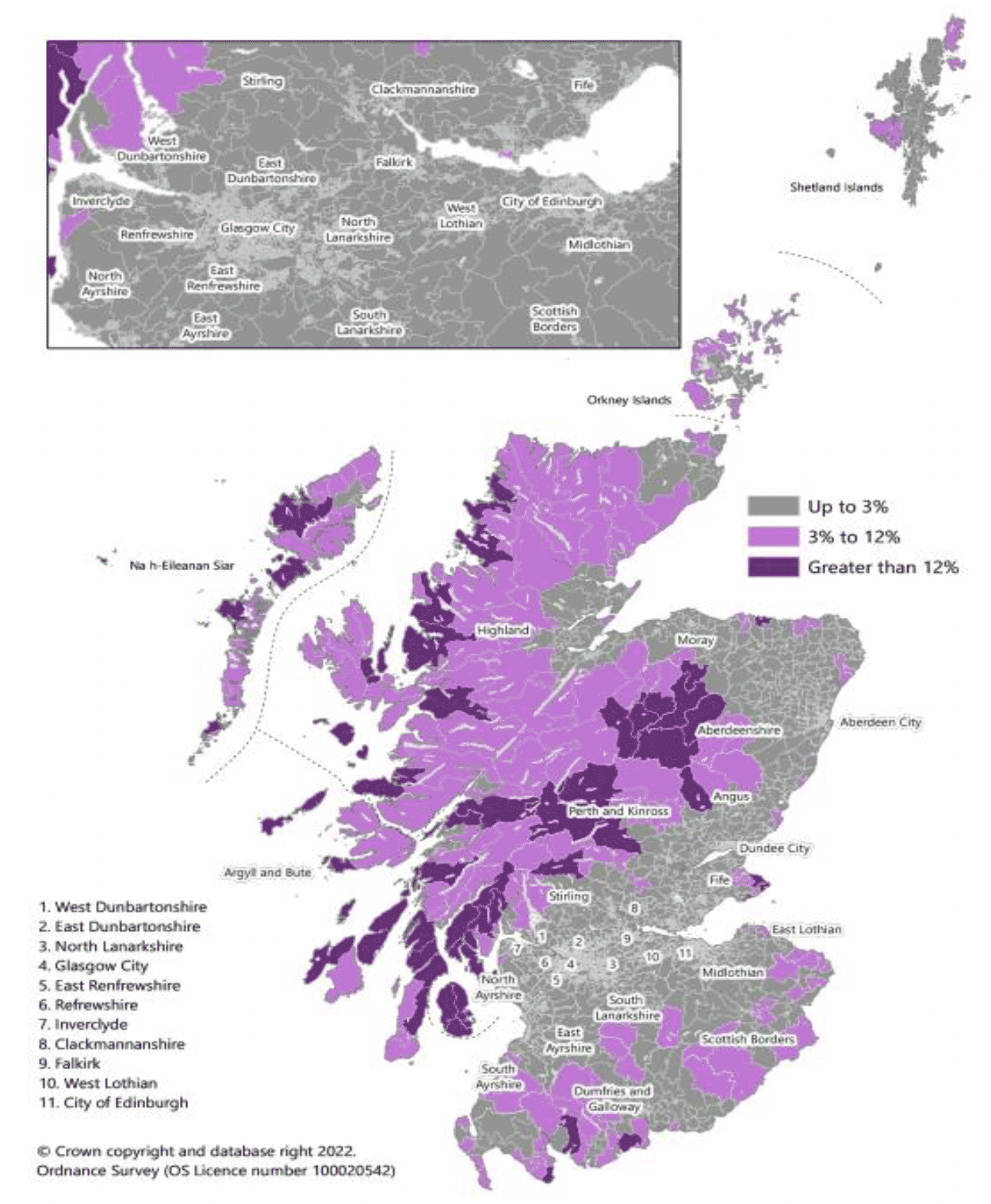
Source: National Records of Scotland (Households and Dwellings in Scotland, 2021 | National Records of Scotland (nrscotland.gov.uk))
The variation of second homes between and within councils shown in Tables 1 and 2 and Figure 3 illustrates the justification for councils to have discretion and flexibility to make local decisions based on local circumstances. This is particularly important as second home ownership can have both beneficial and detrimental impacts on local areas.
Table 3 outlines the number of long-term empty properties (i.e. empty for 6 months or longer) broken down by local authority as at September 2022. As discussed above, while local authorities must provide a council tax discount for these properties, they have a discretion to reduce the discount. The table also shows how many of these properties have been empty for 12 months or longer, for which councils have an additional discretionary power to remove the discount altogether or to charge up to a 100% premium. The table shows that at a Scotland-level, around 70% of properties which have been empty for at least 12 months are being charged a council tax premium or receive less than a 10% discount.[7] This is the result of how many councils use this power (only two councils offer a discount of 10% or higher), how many properties fall within the exceptions set out in the legislation, as well as how many properties are not (immediately) chargeable because of the way in which the council applies the additional discretionary power.[8]
| Local authority | Empty for longer than 6 months | Empty for longer than 12 months | Charged less than 10% discount or premium up to 100% |
|---|---|---|---|
| Aberdeen City | 4,029 | 2,344 | 1,708 |
| Aberdeenshire | 2,543 | 1,805 | 1,421 |
| Angus | 1,261 | 979 | 395 |
| Argyll & Bute | 1,169 | 784 | 644 |
| Clackmannanshire | 250 | 102 | 69 |
| Dumfries & Galloway | 1,418 | 1,169 | 1,169 |
| Dundee City | 1,134 | 456 | 345 |
| East Ayrshire | 527 | 384 | 379 |
| East Dunbartonshire | 250 | 188 | 178 |
| East Lothian | 444 | 315 | 166 |
| East Renfrewshire | 151 | - | - |
| Edinburgh, City of | 6,904 | 2,349 | 1,913 |
| Falkirk | 799 | 362 | 300 |
| Fife | 2,421 | 1,880 | 1,129 |
| Glasgow City | 3,023 | 2,987 | 1,502 |
| Highland | 3,224 | 3,162 | 2,603 |
| Inverclyde | 582 | 337 | 291 |
| Midlothian | 359 | 359 | 160 |
| Moray | 834 | 505 | 432 |
| Na h-Eileanan Siar | 631 | 529 | 349 |
| North Ayrshire | 897 | 506 | 499 |
| North Lanarkshire | 1,846 | 1,072 | 774 |
| Orkney Islands | 211 | 153 | 153 |
| Perth & Kinross | 1,263 | 726 | 699 |
| Renfrewshire | 782 | 314 | 296 |
| Scottish Borders | 1,431 | 922 | 861 |
| Shetland Islands | 552 | 394 | - |
| South Ayrshire | 762 | 274 | 274 |
| South Lanarkshire | 1,531 | 1,400 | 706 |
| Stirling | 546 | 440 | 440 |
| West Dunbartonshire | 598 | 237 | 166 |
| West Lothian | 493 | 258 | 258 |
| Scotland | 42,865 | 27,692 | 20,279 |
Source: Scottish Government (Housing Statistics: Empty properties and second homes)
Empty homes data can also be viewed from the perspective of urban-rural location. Figure 4 illustrates that as at September 2021, large urban areas are the area where the vast majority of long-term empty properties in Scotland are situated, with 18,648 out of 43,766 long-term empty properties (43%) located in such areas. However, large urban areas also have the highest number of dwellings out of the 6 categories. Analysing empty properties as a percentage of the total number of dwellings, it can be seen that remote rural areas have the highest percentage of their housing stock empty for 6 months or more (3.0%), whilst accessible small towns have the lowest percentage (1.1%). Thus, while, like second homes, the greatest concentration of long-term empty homes in the dwelling stock is in remote rural areas, the concentration of empty homes varies less across urban and rural areas than it does for second homes (compare Figure 4 with Figure 2). For example, the share of empty homes in large urban areas is slightly higher than the Scottish average.
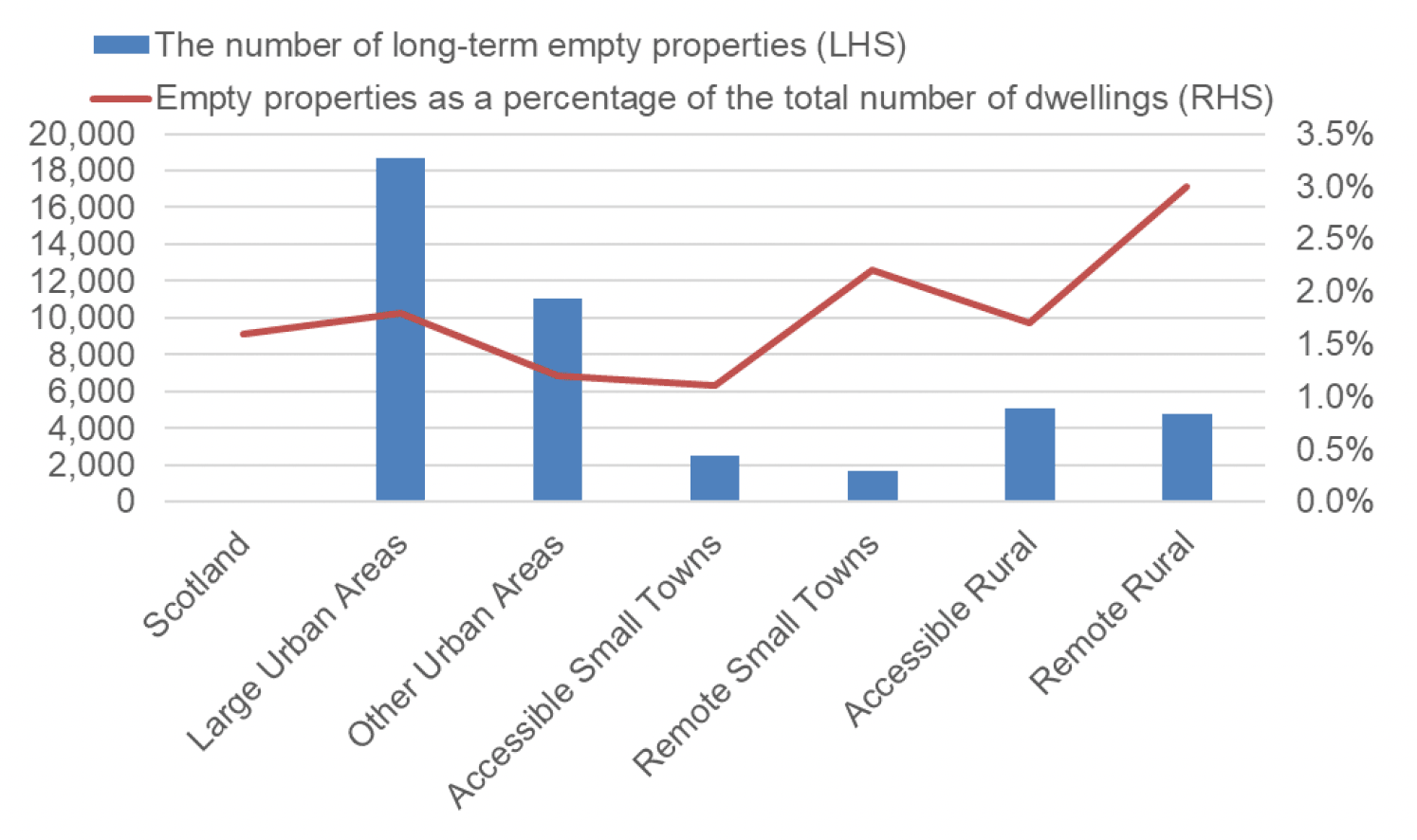
Source: National Records of Scotland, Household and Dwelling Estimates by Urban Rural Classification (2011 Data Zone based)
The Scottish Empty Homes Partnership ("SEHP") collect annual data on why private sector empty properties become and remain empty. The data are presented in Figures 5 and 6, as well as Table 4 and 5, and cover the period from 2018-19 to 2021-22. Figure 5 and Table 4 shows that the previous owner dying and the property being purchased with the intention to renovate were the most common reasons across 2018-19 to 2020-21, and continued to be prevalent in 2021-2022. However, the owner moving without selling and a rent tenancy ending became more prevalent in 2020-21, and were the most common reasons in 2021-22, which may reflect the impact of covid on housing market activity. This illustrates that, while some reasons for homes becoming empty will be relatively persistent over time, temporary trends in housing market activity may also be a factor.
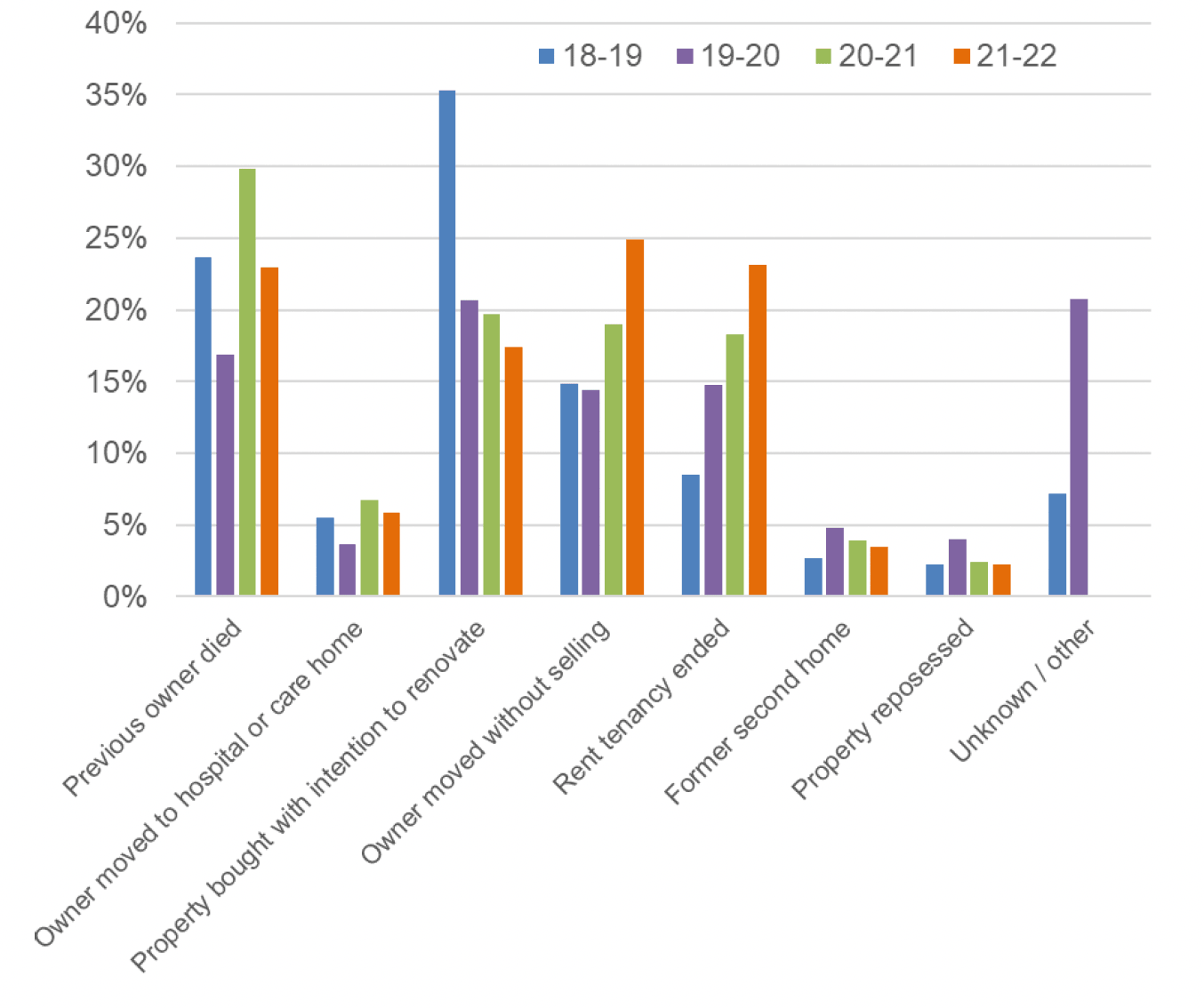
| Why homes become empty | 18-19 | 19-20 | 20-21 | 21-22 | Average |
|---|---|---|---|---|---|
| Previous owner died | 23.6% | 16.9% | 29.8% | 23.0% | 23.3% |
| Owner moved to hospital or care home | 5.5% | 3.7% | 6.8% | 5.9% | 5.5% |
| Property bought with intention to renovate | 35.3% | 20.7% | 19.7% | 17.4% | 23.3% |
| Owner moved without selling | 14.9% | 14.4% | 19.0% | 24.9% | 18.3% |
| Rent tenancy ended | 8.5% | 14.8% | 18.3% | 23.1% | 16.2% |
| Former second home | 2.6% | 4.8% | 4.0% | 3.5% | 3.7% |
| Property reposessed | 2.3% | 4.0% | 2.4% | 2.3% | 2.8% |
| Unknown / other | 7.2% | 20.8% | 0.0% | 0.0% | 7.0% |
Source: SEHP Annual Reports (About us | Scottish Empty Homes Partnership)
When it comes to why an empty home remains empty, the most common reasons on average over the four-year period 2018-19 to 2022-22 (and also in 2021-2022) are difficulty engaging with or locating the owner, the owner being unsure of their next steps, and repair work being in progress, as shown in Figure 6 and Table 5.
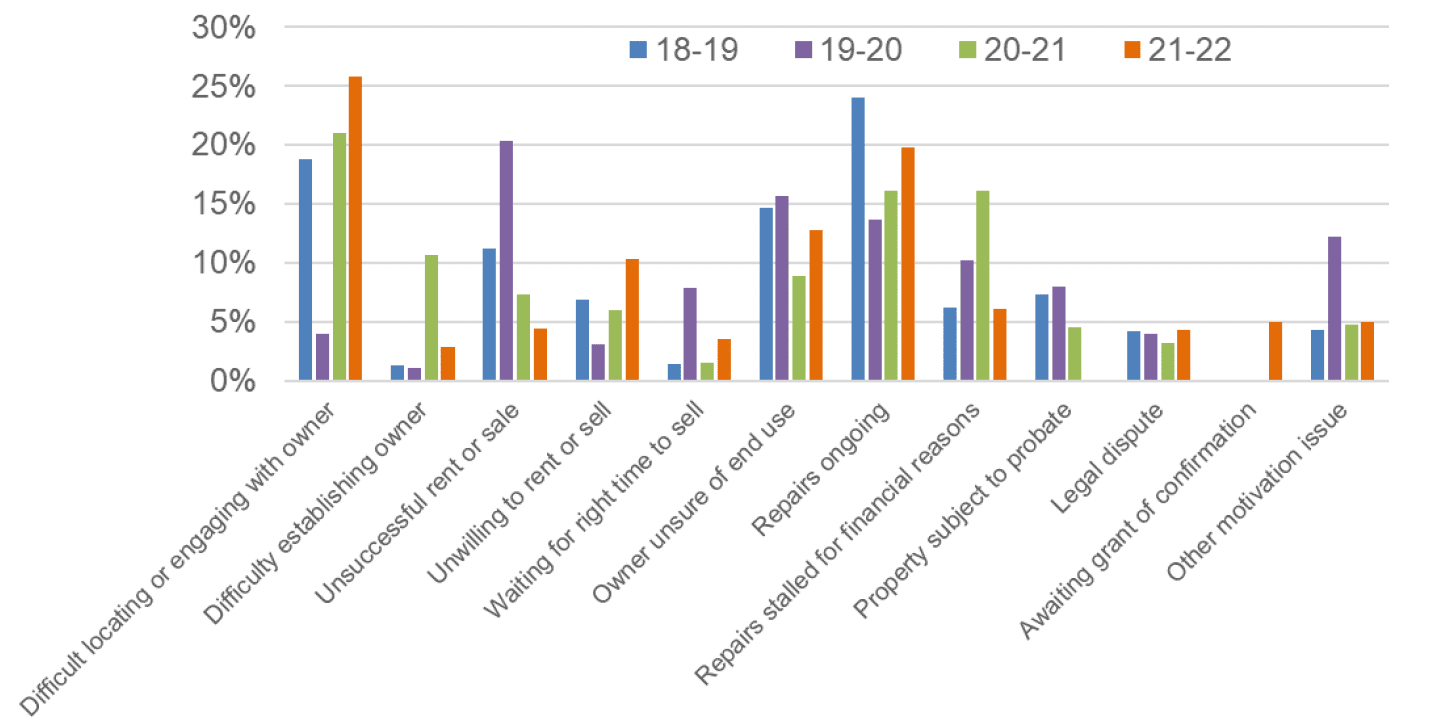
| Why homes remain empty | 18-19 | 19-20 | 20-21 | 21-22 | Average |
|---|---|---|---|---|---|
| Difficult locating or engaging with owner | 18.7% | 4.0% | 21.0% | 25.9% | 17.4% |
| Difficulty establishing owner | 1.3% | 1.1% | 10.6% | 2.8% | 4.0% |
| Unsuccessful rent or sale | 11.2% | 20.4% | 7.3% | 4.5% | 10.8% |
| Unwilling to rent or sell | 6.9% | 3.1% | 6.0% | 10.3% | 6.6% |
| Waiting for right time to sell | 1.4% | 7.8% | 1.6% | 3.5% | 3.6% |
| Owner unsure of end use | 14.7% | 15.6% | 8.8% | 12.8% | 13.0% |
| Repairs ongoing | 24.0% | 13.6% | 16.1% | 19.8% | 18.4% |
| Repairs stalled for financial reasons | 6.2% | 10.2% | 16.1% | 6.1% | 9.7% |
| Property subject to probate | 7.3% | 8.0% | 4.6% | 0.0% | 5.0% |
| Legal dispute | 4.2% | 4.0% | 3.2% | 4.3% | 3.9% |
| Awaiting grant of confirmation | 0.0% | 0.0% | 0.0% | 5.0% | 1.3% |
| Other motivation issue | 4.3% | 12.2% | 4.7% | 4.9% | 6.5% |
Source: SEHP Annual Reports (About us | Scottish Empty Homes Partnership)
It could also be useful to analyse the length of time local authority empty properties have been vacant. However, the reasons why local authority empty properties are left vacant might differ from those in the private sector, with demand for local authority properties very high. Figure 7 and Table 6 highlight the length of time properties have been vacant is closely related to the reason for the vacancy. Normal letting stock, or temporary homeless accommodation tends to be empty for less time than other types of vacant stock. For example, at March 2021 20% of vacant normal letting stock had been vacant for less than two weeks, and only 1% had been vacant for over two years. This compares to just over half (52%) of vacant stock awaiting demolition which was vacant for over two years, and just 1% vacant for less than two weeks.
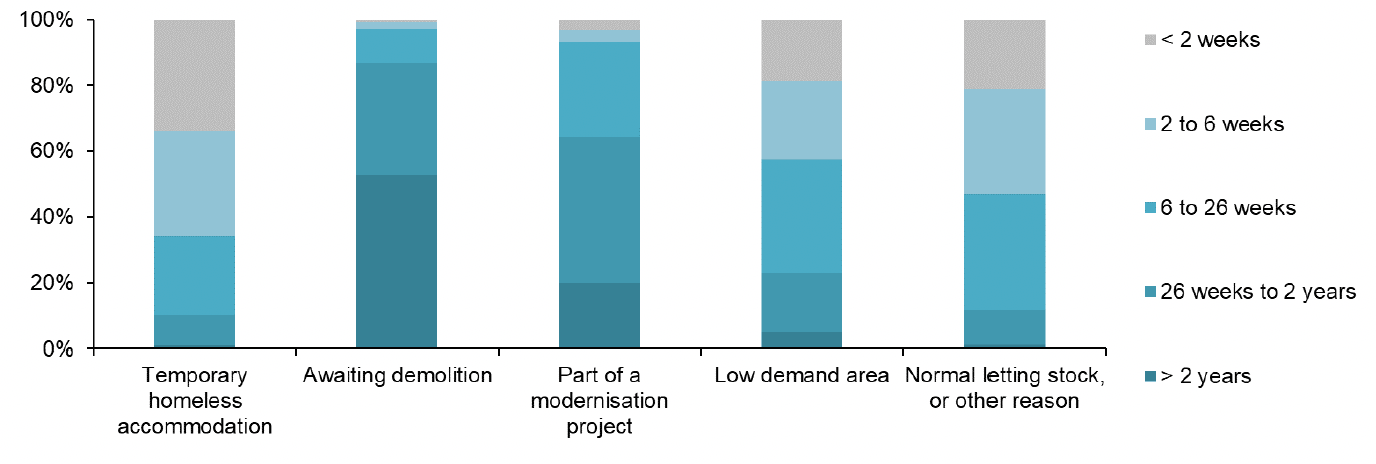
| < 2 weeks | 2 to 6 weeks | 6 to 26 weeks | 26 weeks to 2 years | > 2 years | |
|---|---|---|---|---|---|
| Temporary homeless accommodation | 34% | 32% | 24% | 9% | 1% |
| Awaiting demolition | 1% | 2% | 10% | 34% | 52% |
| Part of a modernisation project | 3% | 3% | 26% | 40% | 18% |
| Low demand area | 19% | 24% | 35% | 18% | 5% |
| Normal letting stock, or other reason | 20% | 30% | 33% | 10% | 1% |
| All | 13% | 20% | 25% | 21% | 17% |
Source: Scottish Government, Housing Statistics 2020 & 2021: Key Trends Summary.
In October 2022 there were 18,290 self-catering accommodation units on the valuation roll for non-domestic rates across Scotland. Self-catering holiday accommodation accounts for 7% of all premises in Scotland liable for non-domestic rates. As seen in Table 10 below there has been a steady rise in self-catering units on the valuation roll over the last 6 years.
The Small Business Bonus Scheme (SBBS) offers up to 100% non-domestic rates relief to non-domestic premises in Scotland with a rateable value below a certain amount. Where the rateable value is low enough, the premises may be eligible for the Small Business Bonus Scheme (SBBS) and receive up to 100% non-domestic rates relief.
In July 2022, 88% (16,130) of self-catering accommodation units on the valuation roll were in receipt of SBBS. As can be seen from Figure 8, the majority of these (96%) benefited from 100% relief and therefore paid no local tax. The cost of this was over £21million.
Non-domestic properties are liable for business water and sewerage charges (property and roads drainage charges are calculated based on the property's rateable value), and waste disposal charges. Anecdotal evidence from councils, however, indicates that self-catering accommodation, though they may be liable for non-domestic rates, do not always face other non-domestic charges. In these cases, the accommodation's direct contribution to local government services would be zero.

Source: Scottish Assessors' Valuation Roll as at 1 July 2022; Councils' billing information
| Number of nights | As % of all listings |
|---|---|
| 1-30 | 40% |
| 31-60 | 17% |
| 61-90 | 11% |
| 91-120 | 8% |
| 121-180 | 11% |
| 180+ | 12% |
Source: Page 5 of Airbnb submission to Scottish Government 2019 consultation on short-term lets.
Further information and data about short-term let activity can be found within the Business Regulatory Impact Assessment published in November 2021.
Scotland's Framework for Tax
The proposals in the consultation align with the principles and strategic objectives set out in Scotland's Framework for Tax to:
a. raise money to fund public services
b. provide economic and social stimulus
c. promote a more equal society through redistribution
d. encourage taxpayers (businesses and/or individuals) to change their behaviour
The onset of the cost of living crisis and related pressures on local finances make it even more imperative to consider how second home owners, and owners of homes which are left empty, could contribute more fairly to local areas and local economies.
Legislative framework
The Scottish Parliament has passed the following regulations, exercising powers set out in section 33(1) to (4) of the Local Government in Scotland Act 2003, that enable councils to change council tax liability for second homes and long-term empty homes.
- The Council Tax (Variation for Unoccupied Dwellings) (Scotland) Regulations 2013
- The Council Tax (Variation for Unoccupied Dwellings) (Scotland) Amendment Regulations 2016
The Scottish Government is responsible for the policy and legislative framework for non-domestic rates, including setting the tax rates and reliefs that it funds.
The Council Tax (Dwellings and Part Residential Subjects) (Scotland) Regulations 1992, as amended by the Council Tax (Dwellings and Part Residential Subjects) (Scotland) Amendment Regulations 2021 set out the current thresholds for self-catering accommodation. To be classed as self-catering holiday accommodation, premises must actually be let for a period of at least 70 days in the financial year and available for let for 140 days or more.
Section 72(4A) of the Local Government Finance Act 1992, as inserted by section 6 of the Non-Domestic Rates (Scotland) Act 2020, makes provision to enable regulations under section 72(4) of the Local Government Finance Act 1992 to give a local authority discretion to determine, in circumstances set out in the regulations, whether particular lands and heritages fall within a class of lands and heritages prescribed in the regulations
The Council Tax (Dwellings and Part Residential Subjects)(Scotland) Regulations 1992 as amended provide councils with the discretion, in exceptional circumstances, to treat self-catering accommodation as if it has met the threshold of being actually let for 70 days.
Objective
Our aim is for everyone in Scotland to live in safe, secure and warm homes. We need to do more to prioritise housing for permanent accommodation, whether this is in the rented sector or home ownership.
The Scottish Government also wishes to increase the occupancy of second and long-term empty homes so that the related economic contribution to the local area is maximised and properties are not left empty without good reason.
We recognise that individuals have the right to own more than one residential property and to decide how they use that accommodation. In considering changes to the council tax treatment of second and empty homes we therefore wish to ensure there is a fair balance between the general interest and the rights of those affected. We will use the consultation process to gather and assess information about the impact of the proposals.
Rationale for Government intervention
The consultation paper sets out the case for change and why taxation, alongside other mechanisms, could help councils make best use of existing housing by managing the numbers of second homes, long-term empty homes and short-term lets according to local needs. The powers we are proposing, that councils have discretion to exercise, require the Scottish Government to bring forward new legislation for consideration and approval by the Scottish Parliament.
Other UK nations have also introduced or are introducing legislation to provide councils with the discretion to use taxation in this way. In Wales, from 1 April 2023, councils can increase the maximum rate from double to four times the full rate of council tax for second and long-term empty homes. In England, the UK Government has already legislated for council tax increases on long-term empty homes and is currently taking forward legislation to give councils powers to double council tax on second homes from April 2024.
From 1 April 2023, the thresholds that apply to self-catering accommodation in the other UK nations for the purpose of non-domestic rates (also known as business rates), are:
- Wales – to be actually let for at least 182 days (increased from 70 days), and available to let for at least 252 days (increased from 140 days) in the last 12 months
- England – to be actually let for at least 70 days and available to let for at least 140 days in the last 12 months
Contact
Email: secondandemptyhomes@gov.scot
There is a problem
Thanks for your feedback